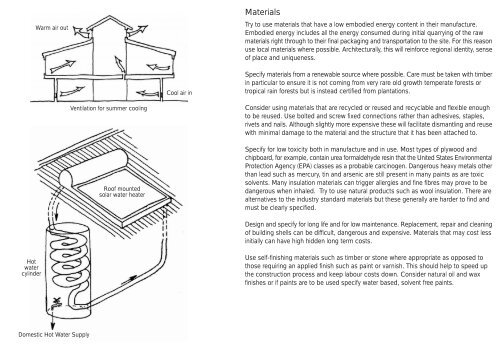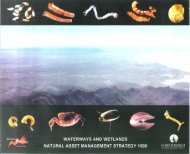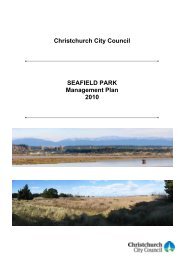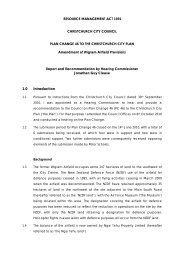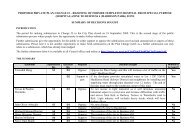Sustainable Building Guide - Christchurch City Council
Sustainable Building Guide - Christchurch City Council
Sustainable Building Guide - Christchurch City Council
You also want an ePaper? Increase the reach of your titles
YUMPU automatically turns print PDFs into web optimized ePapers that Google loves.
Warm air out<br />
Materials<br />
Try to use materials that have a low embodied energy content in their manufacture.<br />
Embodied energy includes all the energy consumed during initial quarrying of the raw<br />
materials right through to their final packaging and transportation to the site. For this reason<br />
use local materials where possible. Architecturally, this will reinforce regional identity, sense<br />
of place and uniqueness.<br />
Cool air in<br />
Specify materials from a renewable source where possible. Care must be taken with timber<br />
in particular to ensure it is not coming from very rare old growth temperate forests or<br />
tropical rain forests but is instead certified from plantations.<br />
Ventilation for summer cooling<br />
Roof mounted<br />
solar water heater<br />
Consider using materials that are recycled or reused and recyclable and flexible enough<br />
to be reused. Use bolted and screw fixed connections rather than adhesives, staples,<br />
rivets and nails. Although slightly more expensive these will facilitate dismantling and reuse<br />
with minimal damage to the material and the structure that it has been attached to.<br />
Specify for low toxicity both in manufacture and in use. Most types of plywood and<br />
chipboard, for example, contain urea formaldehyde resin that the United States Environmental<br />
Protection Agency (EPA) classes as a probable carcinogen. Dangerous heavy metals other<br />
than lead such as mercury, tin and arsenic are still present in many paints as are toxic<br />
solvents. Many insulation materials can trigger allergies and fine fibres may prove to be<br />
dangerous when inhaled. Try to use natural products such as wool insulation. There are<br />
alternatives to the industry standard materials but these generally are harder to find and<br />
must be clearly specified.<br />
Design and specify for long life and for low maintenance. Replacement, repair and cleaning<br />
of building shells can be difficult, dangerous and expensive. Materials that may cost less<br />
initially can have high hidden long term costs.<br />
Hot<br />
water<br />
cylinder<br />
Use self-finishing materials such as timber or stone where appropriate as opposed to<br />
those requiring an applied finish such as paint or varnish. This should help to speed up<br />
the construction process and keep labour costs down. Consider natural oil and wax<br />
finishes or if paints are to be used specify water based, solvent free paints.<br />
Domestic Hot Water Supply


